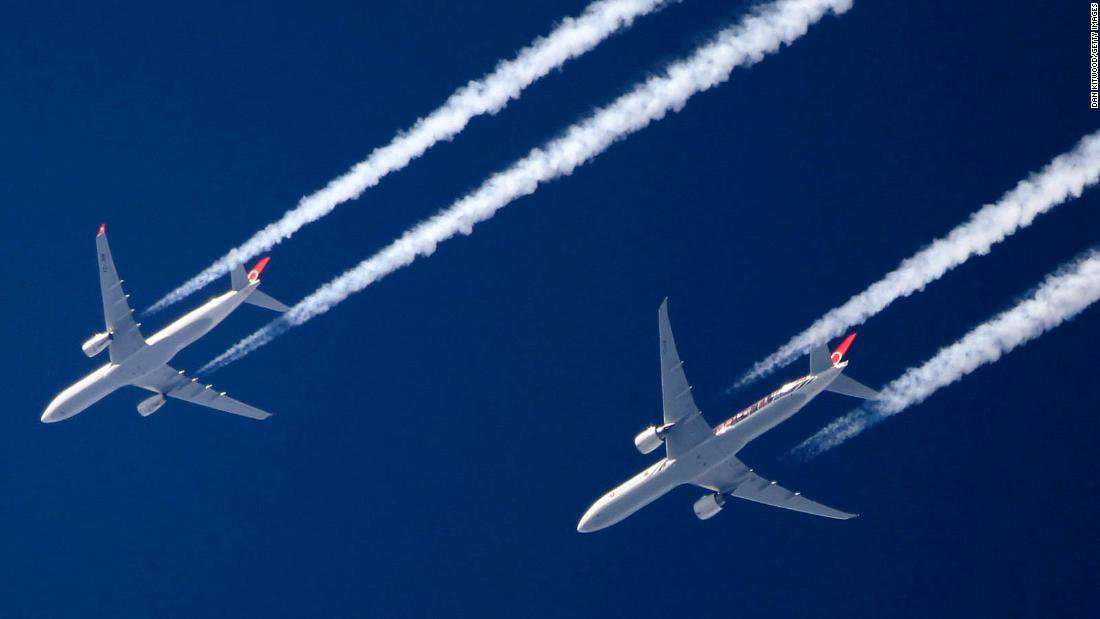(CNN) — Greener fuels, electric engines and more efficient aircraft are all being touted as ways to reduce the environmental harm of flying, but a new study suggests one simple move could help existing flights drastically cut their impact.
By changing the flying altitude by just couple of thousand feet on fewer than 2% of all scheduled flights, a study by a team of scientists at Imperial College London concludes that aviation's damage to the climate could be reduced by as much as 59%.
It's all about eradicating airplane contrails -- those white streaks you see criss-crossing the skies after an airplane has passed overhead.
Contrails, says NASA , are "a type of ice cloud formed by aircraft as water vapor condenses around small dust particles, which provide the vapor with sufficient energy to freeze."
These cloud-like formations can have a cooling effect, acting to reflect sunlight that would otherwise heat the Earth. Contrails can also block outgoing heat from escaping the earth -- essentially acting like a blanket, trapping heat.
In November 2019, a study by a group of MIT scientists concluded contrails account for 14% of climate and air quality damages per unit aviation fuel burn.
The big difference between C02 emissions produced by an aircraft and contrails, however, is that contrails don't last very long, a maximum of about 18 hours.
"So if we were to stop producing contrails, the effect of contrails would go away the next day," says Marc Stettler, who worked on the new study. "It's a way that the aviation industry can really quickly address its impact on climate change."
Flying an airplane higher or lower could help get rid of contrails because they only form in thinner areas of atmosphere, with high humidity -- so it's theoretically possible to avoid them and reap the eco-benefits.
"What we show is that you can make these minor modifications to the altitude of a flight, and avoid that flight from forming a contrail," Stettler tells CNN Travel.
Reducing airplane contrails could help with aviation's impact on climate change. FABRICE COFFRINI/AFP via Getty Images
Stettler and his colleagues experimented with computer simulations to come to their conclusion: using data available on aircraft flying in Japanese airspace, the scientists tested what would happen if aircraft flew higher or lower than their current flight paths.
Diverging from the flight path does lead to an increase in fuel consumption, but the researchers say it's less than a 0.1% rise -- and the subsequent depletion in contrails offsets the extra C02 released.
Andrew Heymsfield, senior scientist at the National Center for Atmospheric Research, tells CNN Travel that the findings make sense, but questions how they could be employed in everyday aviation scenarios.
"The question is, how would they find out what those altitudes are [that] would be less amenable to the development of contrail?" says Heymsfield.
The airplane would have to use instruments that remotely sense humidity, he suggests.
"Those would have to be developed and deployed on an aircraft, so that a 3D depiction of those altitudes could be developed from aircraft which collect those data and then transmit it down to the ground," says Heymsfield.
"Otherwise, I don't know how aircraft air controllers would know where to allow the aircraft to fly."
As Heymsfield points out, aircraft cannot fly anywhere, they have to stick to a specific path.
While the change, if adopted, would have lead to some reduction in emissions, it's unlikely to assuage climate campaigners who want the aviation sector to drastically reduce its carbon footprint. Air travel currently contributes to between 2-3% of all global CO2 emissions and this would remain an issue even if airplanes were flying at different altitudes.
Related content Dirty planet but a clean conscience? The truth about airplane carbon offsetting
Stettler says his team are in discussion with aviation authorities about how their research might work practically.
"We are in the process of having discussions with air traffic management service providers, who are responsible for planning with airlines flight trajectories," says Stettler.

WindCalmTheFarm on February 15th, 2020 at 08:44 UTC »
So this claim sounded fishy to me. Turns out CNN article links to a Science Daily article which refers to this paper: http://dx.doi.org/10.1088/1748-9326/ab4942
Partial summary (quoted) “This work presents a method for comparing the climate and air quality impacts of aviation emissions, by estimating the social costs per unit of emitted mass by species.”
Nothing at all about being able to save the world by removing contrails. The greenhouse gases still come out the back when you burn jet fuel people.
[EDIT - added link]
cousin_stalin on February 15th, 2020 at 06:59 UTC »
I feel like this is part of a misinformation campaign. The thread in r/science about this went into some details as to why this is BS.
itzcoldup-here on February 15th, 2020 at 05:32 UTC »
Airlines already plan the flight paths to burn as little fuel as possible. In order to avoid creating visible water moisture (contrails), an aircraft would have to adjust altitude and flight path during flight as the atmosphere is constantly changing being a fluid.
Focusing on contrails seems trivial, as we cannot control relative humidity. May I suggest upgrading/retrofitting aircraft with newer, more efficient engines. Options such as the PW1500G are double digit percentiles more efficient than conventional turbofan powerplants currently used en masse